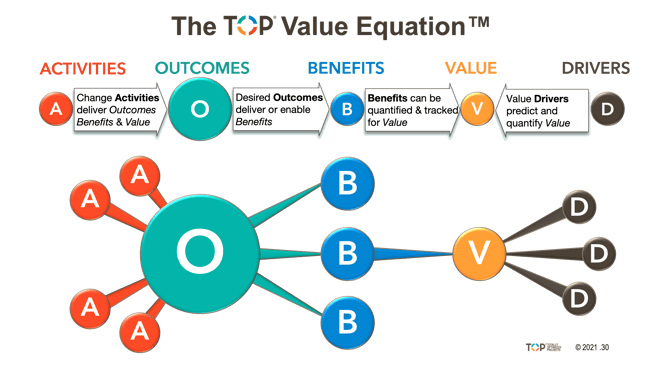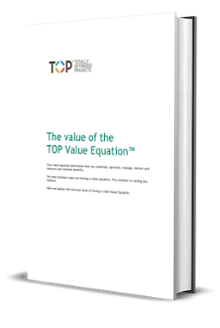The TOP Value Equation™
There is no simpler step you can take to increase the value and performance of your projects than to adopt and use the TOP Value Equation™. We call it “the most powerful Tool in the toolbox” for a reason.
Research has demonstrated that organizations who focus on their strategy execution and value delivery capabilities are in the top 5% worldwide for profitability and shareholder value. Adoption of the Value Equation is the vital first step to moving into this top 5%.
Importantly, the Value Equation defines your business-based measures of project success.
Proven over 15 years of use across all industries, the Value Equation generates your project investment's desired business outcomes, beenfits and value to gether with the changes required to deliver these outcomes. The Value Equation works for all size projects and programs. It can also be done usefully at any time in the project and so can be applied to ‘in-flight’ projects.
Importantly, it is not difficult to learn or do. Let me explain how a Value Equation is generated…
Generating a Value Equation
Although the Value Equation works left-to-right to deliver project value, this is not the order in which it is generated.
Step 1 – Define your Desired Business Outcomes
You start by defining your desired business outcomes. Using your initial objectives, goals or ideas you can progressively translate these through the TOP Oracle and Scribe outcomes definition process into draft outcome statements.
These draft statements are then changed, added to, deleted, amended and refined as necessary as they are reviewed and the subsequent Value Equation steps are executed until, at the business case stage, a final set of desired outcome statements is agreed.
At this stage you can draft your initial ‘Outcomes dependency roadmap’ to identify any gaps in your list of outcomes and identify their delivery sequence. (See step 5 below.)
Step 2 – Identify your Business Benefits
Using your draft list of outcome statements as the reference point you then identify the benefits made possible by each outcome using the TOP Benefits Funnel™ and Double-Pass processes. The benefits identification process may cause you to amend some outcome statements.
Each draft benefit statement is critiqued to ensure it really is a benefit, it is deliverable by the project, and is clear, correctly stated and easily measurable.
This approach avoids unable-to-be-delivered benefits being claimed while ensuring ALL of the available benefits are identified.
Step 3 – Quantify the Financial Value
Next the value of the financial benefits can now be computed. Here the challenge can be finding reliable information on which to base the calculations. These value bases and assumptions (TOP calls them ‘value drivers’) need to be able to be tracked and measured throughout the project and at the time of realization so that you always know the up-to-date value of your benefits. ‘Black box’ calculations that do not show the nature of their value drivers are unacceptable as they cannot be assessed or tracked.
The clarity of your financial benefit calculations is as important at the business case stage as the actual financial value calculated as you need to track the up to date value of each benefit to both ensure your project is viable and to know the full available value to be realized.
Step 4 – Identify the Change Activities required to deliver the Outcomes
Then you identify the current state and the change activities required to realize each desired business outcome (the future state) using the TOP Change Dependency Model™ and Change Identification Framework™.
The identified and structured change activities can then be used to compute the workload and costs using normal project planning techniques.
Step 5 – Develop an Outcomes Dependency Roadmap
Finally, but very importantly, you develop the outcomes dependency roadmap that describes in both graphical and narrative form the interdependencies of the outcomes, their logical sequence of delivery and how each outcome connects and contributes to other outcomes.
This step again may cause the outcome statements to be refined, sometimes outcomes may be split or amalgamated as the logic of their delivery is identified.
The Generation Process
Generation of a Value Equation requires significant thinking but minimal effort. A good quality Value Equation can easily be generated within a few days. And, for all those struggling to generate a worthwhile business case, it can make this process simpler and more rewarding.
The Value Equation Generation Process:

The Value Equation generation process is both sequential and iterative.
As you go sequentially through each process step you are continuously iterating, improving the quality of the outcome statements, the benefit statements and the value as well as refining the change activities.
The degree of change applied to the outcome statements can range from complete rewrites to specific word changes to make sure the outcome is worded exactly right. This attention to detail and specificity pays off as it increases both the value identified and the control you can exert over the project and its workload, while enable you to eliminate waste and costs.
For example, when defining the outcome for bank tellers checking signatures online, the question was raised whether the system should ‘enable’, ‘encourage’ or ‘enforce’ signature checking. You can appreciate the difference each option would make on the end system. (BTW The option chosen was ‘enable’.)
The Value Equation provides you with
- A set of clear, specific and measurable desired business outcome statements which become your primary measure of success. They become the focal point for all project-related activities and the bases of measurement, control and decision making.
- A set of maximized business benefits each attached to the specific outcome that will enable its delivery. These are your secondary measures of success and they can be realized as soon as their enabling outcome has been delivered. This outcome-benefit link eliminates the need for a separate ‘benefits management process’.
- A set of quantified financial benefits whose value drivers are known and able to be tracked and monitored so that the impacts of any changes to these drivers can be computed to ensure the benefit is still worthwhile and the project investment is still viable.
- A set of structured change activities to deliver each outcome that makes clear the size, scale and nature of the change workload required. These activities can then be used to compute the delivery workload, resources and costs.
- An outcomes dependency roadmap that illustrates the sequence of outcomes (and therefore benefits) delivery and their interdependencies so you understand the downstream impacts of project decisions.
Now, often for the first time, you are in full control of your project, its business value and the delivery workload. You have the critical DNA of your project.
You can now:
- Focus the project
Define a subset of the business outcomes as '‘project outcomes’' for the project to deliver. These are defined as clear, specific and measurable statements. It is now quite clear (and measurable) what the project is to deliver. - Focus the project on benefits realization
Allocate to the project the benefits that will be immediately available when these project outcomes are delivered. This ensures these benefits are planned to be realized as part of the project’s delivery plans. - Track the available financial value
Track any changes to the financial benefits’ value drivers so that you always know the up-to-date value of each benefit and the project overall. - Plan the project workload
Allocate the required change activities between the project (to deliver the project outcomes and immediate benefits) and the business (to subsequently deliver the business outcomes and remaining benefits) so that there are no unknowns in terms of the workload involved or who is accountable for delivery. - Assess the impact of decisions on the project’s benefits
Assess and control the immediate and downstream impacts of decisions, deviations and externally caused changes on the project's desired business outcomes, benefits and value through the use of the roadmap. - Track the ongoing value of the project
Easily measure and manage the ongoing relevance, viability and deliverability of the project throughout its duration—identifying early any projects that should be cancelled. - Track when benefits become available
Identify when promised benefits become available—ie on the measured delivery of their delivery outcomes. - Track when benefits have been lost and why
Identify when benefits are no longer available due to either external events or delivery of compromised outcomes (so as to avoid wasting time and effort seeking to realize them). - Measure your success Have you fully delivered each outcome, its benefits and value? As each element is measurable you can easily answer ‘yes or no’ and assess the business consequences.
And more.
The Value Equation equips you to regain full control of your projects, their value and costs—and it is simple, powerful and easy to adopt and use.
Try it today at no risk to see for yourself.





